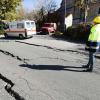Mahuika models fractal patterns in murky water
The Challenge:
To peer through murky waters and understand the patterns that drive muddy currents in rivers and oceans.The Solution:
The creation of a numerical model that helped to explain experiments. A balance was struck between model accuracy and computational power limits to find the best model resolution.The Outcome:
With NeSI, the team were able to create a model that took the results of metre-scale lab experiments and apply them to the rolling movements across kilometres of ocean floor.
Big whorls have little whorls
That feed on their velocity,
And little whorls have lesser whorls,
And so on to viscosity.
This is a poem by Lewis Fry Richardson, an early 20th century polymath who first applied numerical methods for weather prediction.
The poem describes the fractal nature of turbulence where large swirling currents that may be hundreds of kilometres across (such as hurricanes) contain smaller currents, which in turn contain yet smaller ones, down to currents that may only be a millimetre across.
To understand and predict these large events, the patterns of smaller events must be studied. Dr Heide Friedrich is a civil engineer at University of Auckland. Using NeSI’s Mahuika cluster, her team studied these repeating patterns to model the gravity currents of oceans and rivers.
A gravity current occurs when heavier and lighter fluids mix. Underwater, mud and sand can flow horizontally, as mixed with water the heavier sediment-laden flow has enough momentum to flow underneath the lighter water above it.
These underwater avalanches, a type of gravity current known as turbidity currents, can push sediment across kilometres.
“We don’t have a good understanding of the physical processes happening inside these currents. We can simulate them on a small scale through experiments but because they carry sediment they’re opaque. We can use sensors to measure the flow, but these sensors are intrusive; they affect the current. This is why numerical modelling is useful,” Heide said.
Lab experiments by Heide and Richard Wilson were the basis for the models. Heide, PhD student Joë Pelmard, and mechanical engineer Dr Stuart Norris used this experimental data to create their numerical model using NeSI resources. The model showed what was hidden in the muddy water: how smaller currents mixed together to form larger ones.
“A trademark of turbulence is energy transfer. These currents are constantly moving and changing their composition. They don’t look the same after one second. Being able to physically describe the turbulence helped us understand the energy transfer between small and large scales, but the challenge is computational power.”
One important part of this work was the team discovering the minimum resolution the model needed to predict the flow. There is no standardised resolution for turbidity current models. This means less precision between results in the field.
Stuart applied his knowledge of buoyancy driven flow and provided the large eddy simulation code that was used on Mahuika. With this code, the team found an optimum resolution for turbidity flows. Insights from their recent paper, titled Statistical characterisation of turbulence for an unsteady gravity current, as well as a past publication and their experimental work, could be used to help other researchers in this field.
“NeSI gave us the computational power to model these flows. The simulations let us model various spatial scales. Instead of being limited to a couple of metres in a lab we could simulate flows that covers kilometres of ocean floor,” Heide said.
Modelling the 3-dimensional behaviour of turbidity currents requires a great deal of computational power. The more powerful the turbidity flow, the more modelling required to understand it. NeSI was able to provide core hours to Heide’s team. Allocated core hours only impact the computational time minimally for a certain simulation, it is really the use of finer grids that affects how long the computations run.
Heide said several of her students use NeSI outside of this project. In an era where collecting data in experiments is automated and easy, the real challenge becomes processing this data. NeSI helps process data that would be impossible on standard lab computers, as well as giving guidance to users.
Do you have an example of how NeSI support or platforms have supported your work? We’re always looking for projects to feature as a case study. Get in touch by emailing support@nesi.org.nz.







